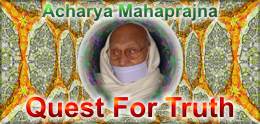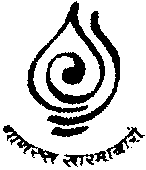
Kabir expressed his feelings in his famous couplet, "When the ego existed, the guru did not and once the guru emerged, the ego had vanished. The reason is that the path of love is so narrow that it cannot accommodate two on it. Only one can traverse it, either my guru or me."
The body and soul cannot be experienced at the same time. Either one or the other is experienced. When we, living within the body, discard it and begin experiencing the soul, then it is called kayotsarg. To experience the soul and stop experiencing the body is kayotsarg. "I am the body," this feeling has been coming down since ages. The moment the identification with the body breaks, the feeling that, "I am not the body," comes alive, kayotsarg comes into being. In death, the body gets left behind but attachment to it is not lost. At the time of death a queer kind of attachment appears in the person. He becomes afraid of death. He is afraid of dying. The fear is that the body will get left behind. The house he lived in will get left behind. Nothing really gets destroyed with death. You make a good house, in time it needs repairs, gets damaged. If you are then invited to live in a new house would you not prefer that? Would you not give up your old house and move into the new? Definitely you would like to move into it. Then why fear death? If our body, which has been with us for so many years, is now worn out and we are presented with a new house, then why not move into it? Fear is not due to the fear of losing the body; the fear is because of attachment to the body. The attachment of the mind is never lost and therefore even with the loss of the body at the time of death, one is not able to do kayotsarg. The moment the attachment to the body is lost, the same moment the body loses its tension and kayotsarg becomes operative by itself. Kayotsarg reduces tensions and also keeps outside influences at bay.
This is an incident even prior to the times of Bhagvan Mahavira. The disciples of Bhagvan Parshav were meditating. Prime among them was monk (muni) Sudarshan. At that time there was a man greatly proficient in mantras, Sukarna Kapalik by name. He was practicing mantra sadhana or the recitation of mantras. He was looking for a man fully endowed with all the attributes required for sacrifice. One day monk Sudharshan, along with some other monks reached Sukarna's place {ashram). Sukarna's disciples saw them and told their master that some Jain monks were coming and that the leader among them appeared to be endowed with all the required attributes. Sukarna sent his staff and they caught the monk Sudarshan and brought him to the ashram. Before him stood the idol of the Goddess. Scattered all around were blood-spattered skulls. He understood that he had been brought for sacrifice. There was neither fear nor worry in his heart. He was taken to the sacrificing altar and made to stand. He did kayotsarg and got into deep meditation.
Sukarna started reciting the mantras. Even as the sword of his disciple Chand reached the neck of Sudarshan it fell off his hand. All the lamps and incense sticks also fell. Sudarshan stood where he was. After some time when he finished kayotsarg he found everybody had fainted. He went out. Taking the waiting monks, he went ahead.
Sukarna and his disciples woke from their stupor. They saw the monk was not there. Sukarna was the best with the mantras in his time. It hurt his pride greatly to find that a man had escaped from his clutches. He got angry and began a yajna to kill the monk. He began the practice for Mahajwala (the goddess of fire). He sacrificed seven men. Mahajwala appeared before him. She waited for his orders. Sukarna said, "Burn monk Sudarshan with his entire brood." Mahajwala went. Some monks were walking with monk Sudarshan. One old monk was walking ahead. Fire played at his feet and he succumbed to it and died. Monk Sudarshan saw this and after warning his fellow monks, stood in kayotsarg. Mahajwala spread fire all around the monks. But she was not able to break the aura around monk Sudarshan. She returned unsuccessful. She came and told Sukarna, "I am burning, appease me."
Sukarna asked if she had burnt Sudarshan. She replied she could not. Losing his temper, Sukarna screamed, "Devil! Is your energy lost? Why did this happen?" Mahajwala replied, "On all four sides of him, his aura had formed an impenetrable shield. I could not pierce through it."
This impenetrable aura, the brilliant shield was the reflection of kayotsarg. Under two circumstances kayotsarg helps: after activity and during moments of difficulty. After the completion of activity kayotsarg brings complete relaxation of physical, muscular and mental tensions. The toxics generated during activity are purged.
An ascetic was walking through a forest. A lion came before him. He stood in kayotsarg. The lion went away. There are many such instances recounted in Jaina literature.
There is truth behind these stories also. Those who do kayotsarg reach that depth of consciousness where the tejas body (the bio-electrical body) becomes more powerful. He becomes so radiant that the person who comes near him loses lustre. There is a secret to the reason for having a radiating personality while doing kayotsarg. It happens automatically when you enter the subtle world of the consciousness.
Kayotsarg increases the power of absorption. When a man wants to imbibe an external energy, he must be free of tension for tension obstructs the absorption of energy. Kayotsarg brings relaxation to the body. In that state it is easy to establish oneness with something else. When the mind and attachment are removed from the body, only the physical body remains. When the body relaxes, the mind relaxes and when the mind relaxes, the body relaxes.
Kayotsarg can be done when we are lying down, sitting or standing. In every part of the body one can experience relaxation. The feeling of relaxation and the resolve to relax: with this method the body relaxes in two or three minutes. Action and thinking are left behind. A certain kind of sleep is experienced. Neither fully awake nor fully asleep, a little sleep and a little alertness; a mixture of the two are experienced. To remain in this state for at least half an hour is beneficial to the mind and the body. Kayotsarg is a technique that teaches to be free from the fear of death. The one who practices kayotsarg well does not die in an unconscious state. He is alert till the last moment when his breathe leaves him and he knows till the last second when his body is being discarded. It is said that the last moment of death is painful. Death is not difficult or painful. It is because of imagination. In death there is an imagination of fear. Because of fear, the ligaments shrink and that is painful. Even a small pain becomes increased because of the shrinking of the ligaments. That we should not have fear, that our muscles should not contract, is possible only by preparing to strengthen the ligaments.
 Acharya Mahaprajna
Acharya Mahaprajna


